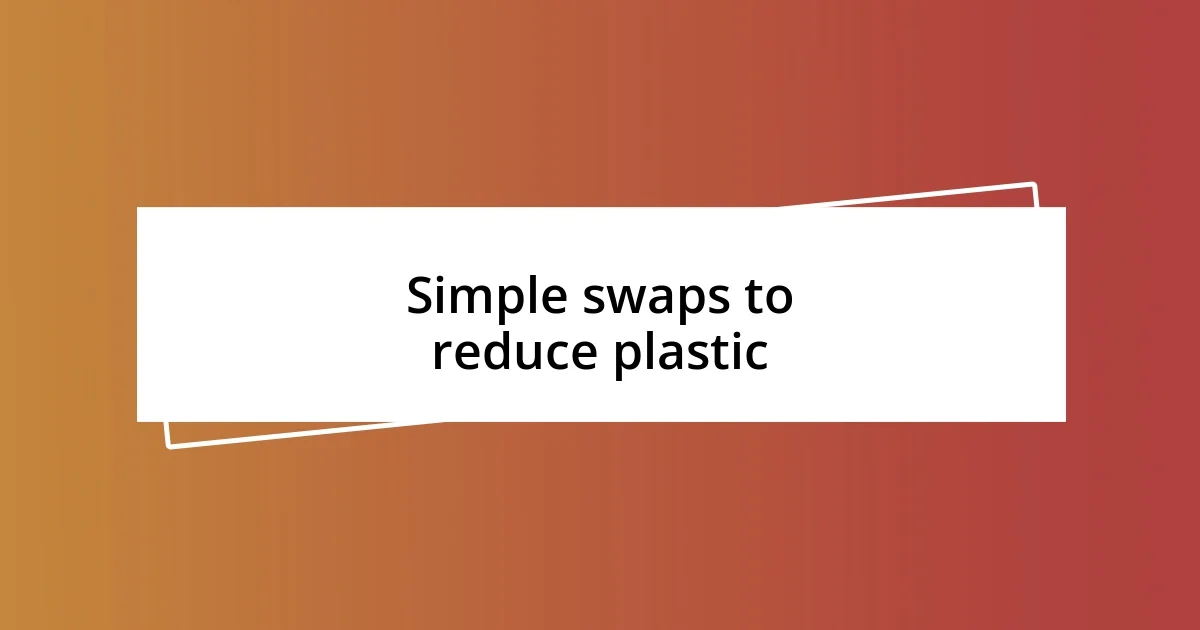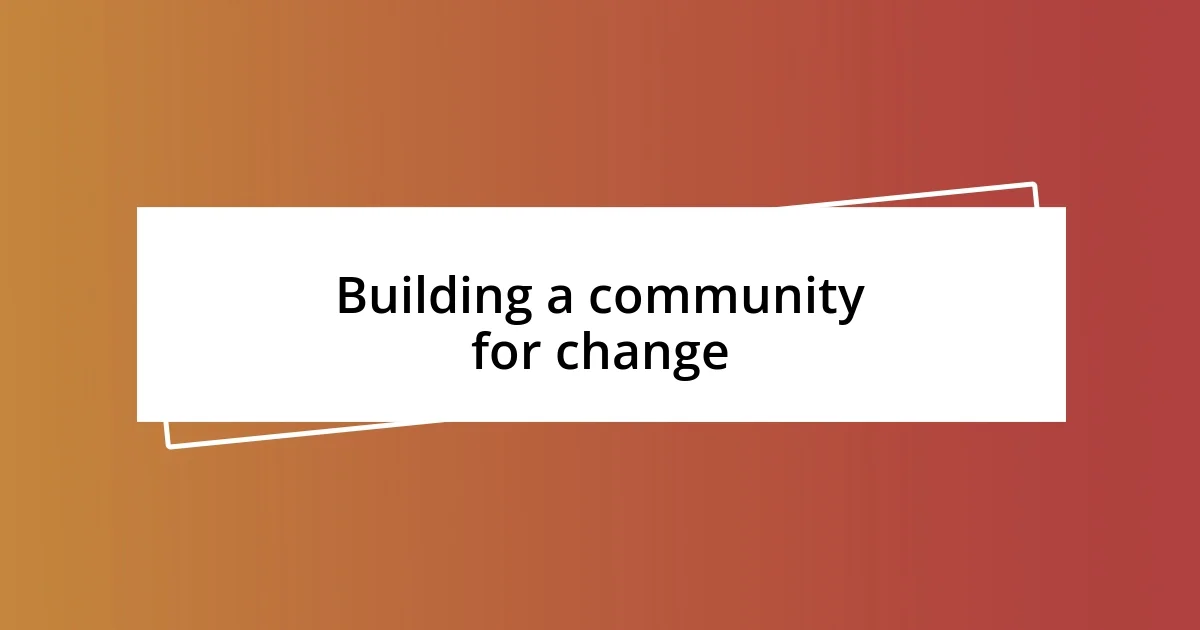Key takeaways:
- The reliance on single-use plastics has severe environmental impacts, including harm to wildlife and significant greenhouse gas emissions from production.
- Simple swaps in daily habits, such as using reusable straws and containers, can greatly reduce plastic waste.
- Building a supportive community and tracking progress helps enhance awareness and encourages collective action towards reducing plastic consumption.

Understanding plastic use impacts
Plastic use impacts our environment in ways that are both visible and hidden. Every time I take a stroll through my neighborhood, I can’t help but notice how many single-use plastic items clutter the streets and parks. It makes me wonder, how did we become so reliant on materials that don’t break down for hundreds of years?
From my own experiences, I’ve seen wildlife suffer from plastic ingestion, leading to injury or death. A few years back, I volunteered at a local wildlife sanctuary, and I was shocked to discover that many animals were brought in with plastic entangled around them. It struck me as both heartbreaking and infuriating; we often forget that our choices have direct consequences on living beings.
Moreover, the production process for plastic is a significant contributor to greenhouse gas emissions. I recently read that manufacturing just one ton of plastic emits nearly two tons of carbon dioxide. This statistic resonates with me deeply, as it prompts me to reevaluate my consumption habits. How can we continue down this path when there are so many alternative materials waiting to be embraced?

Identifying everyday plastic sources
Identifying the everyday sources of plastic in our lives has been an eye-opening journey for me. I remember one morning, as I unpacked my groceries, I was taken aback by the sheer amount of plastic wrappings and containers—everything from produce bags to yogurt cups. It made me realize how seamlessly plastic has woven itself into our daily routines, often without us even noticing.
Here are some common sources of plastic that I’ve identified in my household:
– Grocery bags: Those flimsy, single-use bags seem harmless but accumulate quickly.
– Food packaging: Items like frozen meals often come swaddled in layers of plastic.
– Beverage bottles: I’ve switched to a reusable water bottle, yet it’s startling to think how many plastic bottles I used to consume.
– Personal care products: Many shampoos and lotions come in plastic containers that can last far beyond their intended use.
– Household items: Even cleaning supplies often arrive in plastic bottles, making a simple task feel like a bigger environmental issue.
Reflecting on these sources has driven home how pervasive plastic really is and how crucial it is for us to start making intentional choices.

Simple swaps to reduce plastic
When it comes to reducing plastic in my life, I’ve found that making simple swaps can lead to significant changes. For instance, I used to grab plastic straws without thinking twice. However, switching to reusable metal straws has not only cut down on waste but also adds a touch of style to my drinks. I still remember the first time I brought my own straws to a cafe; it felt empowering to make a small stand against single-use plastic.
Another swap that greatly impacted my plastic footprint was transitioning from plastic containers to glass or stainless steel for food storage. There’s something incredibly satisfying about the weight of a glass jar and knowing it won’t leach harmful chemicals into my food. A friend gave me a beautiful set of reusable food wraps made from beeswax, and I’ll admit, I initially hesitated. But once I started using them, I quickly became hooked. They keep my leftovers fresh and make my kitchen look much tidier without the clutter of plastic wrap.
Lastly, opting for bar soap instead of liquid soap in plastic bottles has been a game changer for me. Not only does it reduce plastic waste, but I also enjoy the wide variety of scents and textures available. I fondly recall a delightful afternoon spent at a local market, where I discovered artisanal bars wrapped in paper. It felt like a win-win—for my skin and the environment.
| Plastic Item | Simple Swap |
|---|---|
| Plastic straws | Reusable metal straws |
| Plastic food containers | Glass or stainless steel containers |
| Liquid soap in plastic bottles | Bar soap |

Tips for sustainable shopping habits
Sustainable shopping habits have become an integral part of my routine, and a little planning goes a long way. Before heading out, I always prepare a shopping list to avoid impulsive purchases and the inevitable plastic waste that follows. I remember the first time I deviated from my list—I came home with an item I didn’t need, wrapped in multiple layers of plastic. The disappointment of realizing I contributed to the very problem I was trying to reduce was a real wake-up call for me.
I’ve learned that supporting local markets is another way to shop sustainably. When I visit my local farmers’ market, I not only enjoy fresher produce but also have the chance to bring my own reusable bags. It’s a rewarding experience to chat with vendors who share stories about their products. Plus, I’m amazed at how many items come without any packaging. Isn’t it refreshing to see fresh fruits and vegetables displayed without all that plastic? I get a rush of excitement knowing my choices directly support both the environment and local farmers.
Also, I never overlook the power of researching brands before I shop. I recall discovering a beauty product brand committed to reducing plastic in their packaging. One afternoon, I spent a few minutes browsing their website, and I was genuinely moved by their transparency and dedication. It made me think, what if we all did a little research before every purchase? The sense of purpose I felt after choosing a brand aligned with my values only strengthened my resolve to continue making conscious decisions in my shopping habits.

Practical steps for minimal waste
When it comes to practical steps for minimal waste, one of my favorites is creating a habit of carrying my own reusable shopping bags. I remember a time when I forgot my bags and had to rely on plastic ones—it felt like a small defeat. Now, I keep a stash of compact, foldable bags in my car and purse, making it convenient and almost effortless to avoid single-use plastic. Have you ever experienced that moment of realization when you successfully use your own bag? It’s like a badge of honor in my efforts to reduce waste.
I also make an effort to opt for products with minimal packaging whenever possible. One day, I stumbled upon a brand that sold dry goods in bulk without any wrapping at all. The thrill I felt filling my own containers at the bulk aisle was unforgettable! Not only do I get to enjoy my favorite nuts and grains without excess plastic, but I also appreciate the tangible impact I’m making. It’s fascinating how even small tweaks in our shopping routine can lead to big changes, right?
Another step that I find effective is keeping a “waste diary” to track my plastic use. It started as a casual experiment, but soon became a powerful tool for self-awareness. Each week, I jot down the plastic items I used and reflect on how I could do better. There’s a unique sense of accountability that comes with it. How often do you pause to evaluate your own habits? I’ve found that this exercise not only highlights areas for improvement but also celebrates my progress over time. Seeing how far I’ve come motivates me to stay committed to my goal of minimal waste.

Building a community for change
Building a community for change starts with connection and shared goals. I remember going to a local event focused on sustainability, where people gathered to discuss everything from waste reduction to composting. It felt empowering to share my experiences, learn from others, and realize we all had the same goal: a cleaner planet. Have you ever felt that sense of belonging among like-minded individuals? It can really spark motivation and creativity in how we approach reducing plastic in our lives.
Creating and participating in local groups has been instrumental for me. Whether it’s a neighborhood clean-up or a discussion group on sustainable practices, it opens the door to new ideas and influences my actions. I once joined a book club dedicated to reading about environmental issues, and it opened my eyes to so many aspects of sustainability I hadn’t considered. The conversations we had often transitioned into practical solutions we could implement together. Isn’t it incredible how just a few shared discussions can lead to meaningful changes?
Additionally, leveraging social media to connect with others on this journey has transformed my approach to reducing plastic. I once posted about my zero-waste goals and was surprised at how many friends reached out to share their tips too. Seeing others’ progress and challenges strengthened my resolve. Each shared experience fosters a supportive environment where we can learn from each other. Don’t you think that when we rally together, we amplify our impact? That’s the kind of community that drives real change.

Tracking progress in plastic reduction
Tracking progress in plastic reduction has been a game-changer for me. I started using an app to log my daily plastic use, and the results were eye-opening! Each entry reminded me of my commitment and helped me pinpoint specific areas where I could improve. Have you ever tracked your habits? It’s fascinating how seeing your actions laid out can reveal patterns you might not notice otherwise.
As I continued to monitor my usage, I also began setting monthly goals for myself. For example, one month I focused on reducing plastic straws. I knew I could do better, and I challenged myself to seek alternatives. Initially, I felt a mix of excitement and apprehension—would I be able to stick to it? But by the end of that month, I had successfully swapped out single-use straws for reusable ones, and the pride I felt was incredible. It’s rewarding to set tangible objectives and celebrate those small victories.
One of the most impactful things I’ve done is to compare my monthly logs. Reflecting on how my plastic footprint has shifted over time is not just encouraging; it fuels my determination. I even printed out my best months and pinned them on my wall like a badge of honor! It serves as a powerful reminder that progress is possible and that each small change contributes to a larger impact. Have you noticed how tracking progress makes you more conscious of your choices? It’s remarkable how this awareness can reshape our habits and motivations.














